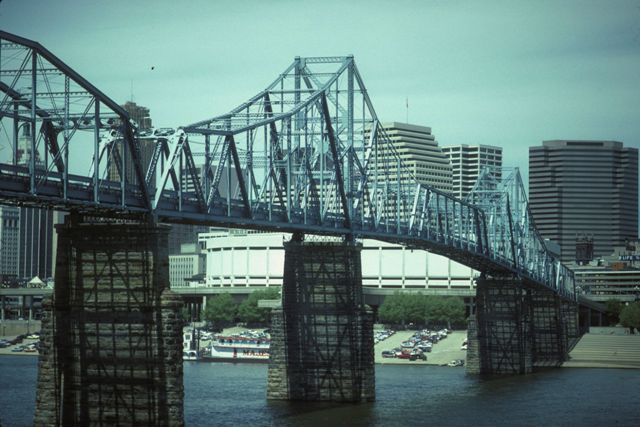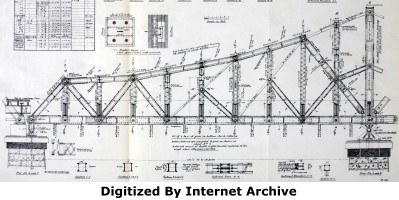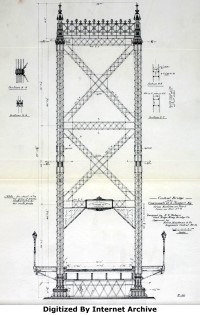We Recommend:
Bach Steel - Experts at historic truss bridge restoration.
BridgeHunter.com Phase 1 is released to the public! - Visit Now
Central Bridge

Primary Photographer(s): Dave Michaels
Bridge Documented: 1985-1989
Cincinnati and Newport: Hamilton County, Ohio and Campbell County, Kentucky: United States
Metal 40 Panel Pin-Connected Pratt Through Truss, Fixed and Approach Spans: Metal 7 Panel Pin-Connected Pratt Through Truss, Fixed
1891 By Builder/Contractor: King Bridge Company of Cleveland, Ohio and Engineer/Design: Ferris, Kaufman, and Company of Pittsburgh, Pennsylvania
Not Available or Not Applicable
520.0 Feet (158.5 Meters)
2,342.0 Feet (713.8 Meters)
22.6 Feet (6.89 Meters)
3 Main Span(s) and 15 Approach Span(s)
0190027B0036

View Information About HSR Ratings
Bridge Documentation
This bridge no longer exists!
View Archived National Bridge Inventory Report - Has Additional Details and Evaluation
View Historic American Engineering Record (HAER) Documentation For This Bridge
This quintessential historic pre-1900 cantilever truss bridge was demolished in 1992!
View A Detailed Discussion of This Bridge
Higher Quality Plan Sheets and Photos From Above Article
About This Bridge
This bridge was one of the most important historic bridges in the United States.
The bridge was one of the largest and most complex achievements of the King Bridge Company, which was one of the most prolific and most creative (holding several patents) bridge builders of the 19th Century.
The bridge was remarked as one of the first of its kind ever constructed, and its design served as a prototype for cantilever truss bridge construction that would occur throughout the coming 20th Century in North America. Some of the greatest and most complex bridges ever built in North America were cantilever truss bridges, and one could argue that much of it all started with this bridge. Indeed, despite the age of the bridge and its prototypical nature, it is surprising how much the shape of this cantilever truss bridge is similar to the cantilever truss bridges that were built in larger quantities decades later such as in the 1920s and 1930s. One would normally expect a prototypical bridge to have a very bizarre design and appearance. In this sense, it is clear that the King Bridge Company had a solid understanding of bridge engineering and was readily able to arrive at the most effective design for this bridge type, despite limited numbers of prior examples.
Aside from this similarity in overall shape with cantilever truss bridges to come in future decades, this is where similarity ended. As a pre-1900 truss bridge, it combined the infinitely complex beauty of the cantilever truss with the unique taste for decoration and embellishment of the late 19th century bridge world. This bridge was adorned with beautiful plaques and extremely decorative portal cresting, as well as decorative knees on the portal bracing.
The bridge was presumably built using wrought iron rather than steel for tension members. As such, it was probably among the largest truss bridge spans ever constructed with wrought iron composing substantial members. At the time of demolition is most certainly was one of if not the largest truss spans with wrought iron remaining.
The bridge also had ornate pedestrian railings that followed a particular design that HistoricBridges.org has categorized as the "arch lattice" type of railing. This distinctive railing combines the features of the gothic arch with the features of a lattice to form a uniquely beautiful railing. The railing design tends to pop up on just about any type of bridge in any location, but is exceedingly rare. The exact design varies.
An Entire Era of History Destroyed Forever
First off, it bears clarification. This bridge was demolished in 1992. 1992 A.D. It was not demolished in the 1960s, when historic preservation was an unheard of concept to the general public and rampant urban renewal projects threatened to destroy nearly every form of historic structure in the United States. This bridge was demolished in 1992. This was after the preservation of historic bridges had been declared by Congress to be in the National Interest, with the establishment of the Historic Bridge Program in 1987. This bridge was not demolished in decades past, long before the concept of a historic bridge was realized. Although 1992 was many years ago, it was not so long ago in terms of historic bridge awareness.
That said, the demolition of this bridge was one of the greatest atrocities against historic structures in the United States ever encountered in the post-urban-renewal era. This is a bridge so significant it should have been preserved at any cost. If it could not carry vehicular traffic, it should have been preserved for pedestrian use. But it should never... never have been demolished. Demolishing the bridge shouldn't even have been a thought or consideration. Worse, the final 1992 National Bridge Inventory report for the bridge suggested this bridge was not even in that bad of a condition. Both the substructure and the superstructure was rated as Fair (5/9), with the deck rated Satisfactory (6/9). This bridge absolutely could have been maintained for pedestrian use. Even though costs should not have been a consideration for preserving this bridge, with ratings such as this, the reality is that this bridge could probably have been preserved for a very reasonable cost indeed.
In the mere seconds it took to blow this bridge up and reduce it to rubble, an entire segment of bridge history in the United States was lost forever. This bridge was the last remaining example of a pre-1900 monumental cantilever truss bridge, and the last remaining example of a truly prototypical cantilever truss bridge in the United States. Now that it is gone, there are no examples of its kind left. This history can never be recovered. The only thing that can be gained from this loss is a warning of the cost of neglecting to preserve those historic bridges which remain today. Sooner or later, there ends up being only one example left, and if that bridge is demolished, an entire chapter of transportation heritage is lost forever.
Canada: Final Hold of the Early North American Cantilever Trusses
In North America, only Canada retains a remnant of this key development period of the cantilever truss bridge. The Waneta Bridge (photo and photo), in Kootenay Boundary, extreme southern British Columbia, just north of the United States border, built in 1893, follows the traditional through cantilever design and is an early example. Fortunately, British Columbia has had the good sense to preserve this example, as evidenced by repairs to the bridge in 2007.
Interestingly, Canada also has another one of the other oldest highway cantilever truss bridges remaining, the Alexandra Bridge in Ottawa, Ontario, built in 1901. Also, while not one of the early cantilever truss bridges, Canada contains the largest cantilever truss span in the world, in the Quebec Bridge.
Canada is also home to the oldest cantilever truss in North America, although it is a deck truss and more experimental in design.
Other Notes
Be sure to read the Historic American Engineering Record data pages for a more detailed history of this bridge.
Special thanks to Dave Michaels for photographing this bridge in the 1980s. Over a decade before HistoricBridges.org was formed, and many years before digital cameras existed (and you had to deal with costs and effort with developing photos), Dave took the time and effort to shoot a considerable number of photos of this bridge. These color photos supplement the black and white HAER photos, by providing photos that contain color, which is so essential to documenting the true appearance and feel of the bridge and setting.
This bridge is tagged with the following special condition(s): Arch Lattice Railing
![]()
Photo Galleries and Videos: Central Bridge
Bridge Photo-Documentation
Original / Full Size PhotosA collection of overview and detail photos. This gallery offers photos in the highest available resolution and file size in a touch-friendly popup viewer.
Alternatively, Browse Without Using Viewer
![]()
Bridge Photo-Documentation
Mobile Optimized PhotosA collection of overview and detail photos. This gallery features data-friendly, fast-loading photos in a touch-friendly popup viewer.
Alternatively, Browse Without Using Viewer
![]()
Maps and Links: Central Bridge
This historic bridge has been demolished. This map is shown for reference purposes only.
Coordinates (Latitude, Longitude):
Search For Additional Bridge Listings:
Bridgehunter.com: View listed bridges within 0.5 miles (0.8 kilometers) of this bridge.
Bridgehunter.com: View listed bridges within 10 miles (16 kilometers) of this bridge.
Additional Maps:
Google Streetview (If Available)
GeoHack (Additional Links and Coordinates)
Apple Maps (Via DuckDuckGo Search)
Apple Maps (Apple devices only)
Android: Open Location In Your Map or GPS App
Flickr Gallery (Find Nearby Photos)
Wikimedia Commons (Find Nearby Photos)
Directions Via Sygic For Android
Directions Via Sygic For iOS and Android Dolphin Browser
USGS National Map (United States Only)
Historical USGS Topo Maps (United States Only)
Historic Aerials (United States Only)
CalTopo Maps (United States Only)





